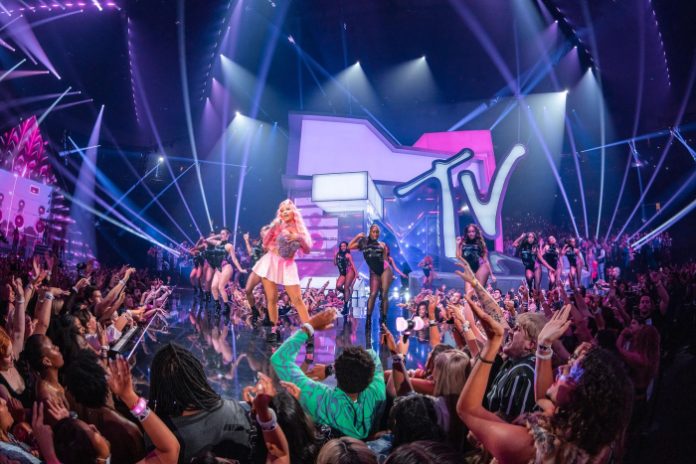
MTV VMAs (Video Music Awards) 2022 was staged at the Prudential Center in Newark, New York, and lit for the third year by Tom Sutherland of DX7 Design, who utilised 229 Robe fixtures among others on a vast lighting rig.
Sutherland collaborated with Set Designer, Heather Shaw of Vita Motus; Camera Director, Liz Clare; Creative Director, Paul Caslin; Screen Producer, Trevor Burke of Visual Noise Creative and Executive Producers, Bruce Gillmer, Jesse Ignjatovic and Barb Bialkowski to help craft the show. The stage design featured two triangular-shaped stages built at the long ends of the arena with LED floors and each with large upstage triangular LED screens.
In the middle of one long side was the ‘MTV Entrance’ – a large scenic graphic of the channel’s famous acronym, where artists entered the arena, stepping onto the chevron-shaped MTV Stage. A short tunnel at the back of the entrance revealed another LED screen, and the short runway also had an LED floor and sides. Much of the presenter action happened in this zone which was a popular celebrity ‘hot spot’.
While that was a lot of LED for the LD to consider, he was the first to note that “working with Heather is great as she always considers the role of lighting relative to her set design.” The two had also worked together on some previous projects in Asia. The layout of the two stages facilitated the full-tilt festival style ‘flip-flop’ of live artist performances that kept the pace and the vitality of the show pumping.
Sutherland positioned 76 Robe MegaPointes, 38 per screen, around the triangular LED screen perimeters on each stage, with eight more a side on two deck-based diagonal raised ‘slip’ positions at the back of the artist / VIP area, either side of the MTV entrance.
“MegaPointes were an easy choice,” stated Sutherand. “I needed something with plenty of power, definition and variety to cut through everything and enhance the geometry of the room, so MegaPointe was my go-to!”
The 2022 MTV VMAs proved every bit as dramatic & entertaining as fans have come to expect of this live broadcast staged at the Prudential Center & lit by Tom Sutherland of @dx7design utilizing 229 @Robelighting luminaires supplied by @Solotech_Inc. (📸 Alive Coverage) pic.twitter.com/GPl8YetNeY
— Robe Lighting (@Robelighting) October 11, 2022
Thousands of variant MegaPointe looks and mountains of dancing and piercing beam looks were crafted to support the different artists’ performance narratives. The lower sections of the two screens’ trussing framework were removable to allow rolling risers and other stage trucks loaded with kit, scenic elements or backline to load on and off the stage smoothly.
The main overhead roof truss structures were also designed largely on a triangular theme to keep the symmetry intact and to achieve the best lighting positioning. Dotted around this vast airspace were 85 BMFL WashBeams to cut through the brightness of the screens, helping eliminate shadows for the 22 camera positions as well as making up the base presenter and house lighting looks that defined the overall architecture and aesthetics from their 50ft trim height.
A further 36 Spiider moving lights were utilised in the tunnel behind the MTV stage and in its entranceway and for back lighting presenters on the chevron stage, and there were four ESPRITES in the floor specials packages available on each stage with 16 RoboSpot systems ensuring the stage was illuminated. Eight remote controlled BMFLs per stage – comprising 10 BMFL FollowSpots and six BMFL LT fixtures – provided the principal key and back lighting. The fixtures were dotted all over the trussing network in the roof and offered the flexibility and punch needed to ensure everyone could always be lit optimally.
“Being able to get all the different angles and change fixtures mid show, effectively getting a light into any position it is needed has been a game changer in the world of follow spotting,” declared Sutherland, adding that it brings the possibility of “lighting large television and broadcast shows like this with so much more precision and theatricality – it is amazing!”
RoboSpot base stations were all located on one of the venue concourses ensconced behind the big ‘M’ of the MTV entrance scenic piece. The operators had control of pan, tilt, iris, and dimmer, with all other parameters running through the main lighting console.
Joe Holdman and Brian Jenkins were the main console operators, with the former taking care of the FX lighting including all the moving lights and all the LED pixels on the rig, and Jenkins ensuring that all the key lighting was in place and co-ordinating the RoboSpot system.
They were joined by Senior Associate Designer and Lighting Director, Hunter Selby; Lighting Directors, James Colidcott and Jasmine Lesane; Lighting Programmer, Stefan Zubocic – who dealt with around 100,000 PixMob LED wristbands on site; Lighting Intern, Noah Bresler; Gaffer, Alen Sisul; Lighting Techs, Dennis Sisul and John Cox and Media Server Operator, Kirk Miller.
Lighting was supplied by Solotech – managed by Harry Forster and Dave Evans – and Sutherland’s visual design also included approximately 50 lasers supplied by ER Productions.
“As always it was the teamwork, professionalism and the camaraderie that made it rock, not just from us in technical production, but those from every production aspect and all on the artists’ side, which made it so special, and such a slick operation that we were all proud to deliver,” concluded Sutherland.





